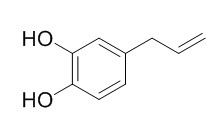4-Allylpyrocatechol
4-Allylpyrocatechol has antioxidant activity, it has protective activity against the photosensitization-induced damage to lipids and proteins of rat liver mitochondria, which attributes to its free radical and singlet oxygen scavenging properties.
Inquire / Order:
manager@chemfaces.com
Technical Inquiries:
service@chemfaces.com
Tel:
+86-27-84237783
Fax:
+86-27-84254680
Address:
1 Building, No. 83, CheCheng Rd., Wuhan Economic and Technological Development Zone, Wuhan, Hubei 430056, PRC
Providing storage is as stated on the product vial and the vial is kept tightly sealed, the product can be stored for up to
24 months(2-8C).
Wherever possible, you should prepare and use solutions on the same day. However, if you need to make up stock solutions in advance, we recommend that you store the solution as aliquots in tightly sealed vials at -20C. Generally, these will be useable for up to two weeks. Before use, and prior to opening the vial we recommend that you allow your product to equilibrate to room temperature for at least 1 hour.
Need more advice on solubility, usage and handling? Please email to: service@chemfaces.com
The packaging of the product may have turned upside down during transportation, resulting in the natural compounds adhering to the neck or cap of the vial. take the vial out of its packaging and gently shake to let the compounds fall to the bottom of the vial. for liquid products, centrifuge at 200-500 RPM to gather the liquid at the bottom of the vial. try to avoid loss or contamination during handling.
Korean Herb. Med. Inf.2020, 8(2):243-254.
BMC Complement Altern Med.2014, 14:352
J Chromatogr B Analyt Technol Biomed Life Sci.2022, 1203:123307.
Chinese J of Tissue Engineering Res.2022, 26(17): 2636-2641.
J Hematol Oncol.2018, 11(1):112
Metabolites.2019, 9(11):E271
Molecules.2017, 22(6)
Pharmaceutics.2021, 13(11):1839.
Chemistr of plant2016, 2016021195
Phytomedicine.2022, 99:153997.
Related and Featured Products
Food Chem., 2007, 100(4):1474-80.
Inhibitory property of Piper betel extract against photosensitization-induced damages to lipids and proteins[Reference:
WebLink]
The protective activity of Piper betel ethanolic extract (PE) against the photosensitization-induced damage to lipids and proteins of rat liver mitochondria has been studied.
METHODS AND RESULTS:
PE could effectively prevent lipid peroxidation, as assessed by measuring thiobarbituric acid reactive substances, lipid hydroperoxide and conjugated diene. In addition, it prevented photo-induced oxidation of proteins in a concentration-dependent manner. Furthermore, its preventive capacity against iron-mediated lipid peroxidation was also confirmed.
CONCLUSIONS:
The protective activity of PE could be attributed to its free radical and singlet oxygen scavenging properties. The activity of PE was primarily due to its phenolic constituents, which were identified as chavibetol and 4-Allylpyrocatechol.
Zhong Yao Cai. 2014 Jan;37(1):69-71.
Chemical constituents from twigs of Piper hancei.[Pubmed:
25090708]
To investigate the chemical constituents from the twigs of Piper hancei.
METHODS AND RESULTS:
The chemical constituents were isolated and purified by means of chromatographic techniques including silica gel,Sephadex LH-20 and preparative RP-HPLC. Their structures were elucidated on the basis of physicochemical properties and spectral analysis.
Eight compounds were isolated and identified as 4-Allylpyrocatechol(I), piperlonguminine(II), d-sesamin(Ill), beta-sitosterol (IV), pellitorine(V), piperolactam A(VI) and piperolactam D(VII), respectively.
CONCLUSIONS:
Compound I, III, VI and VII are isolated from Piper hancei for the first time.



